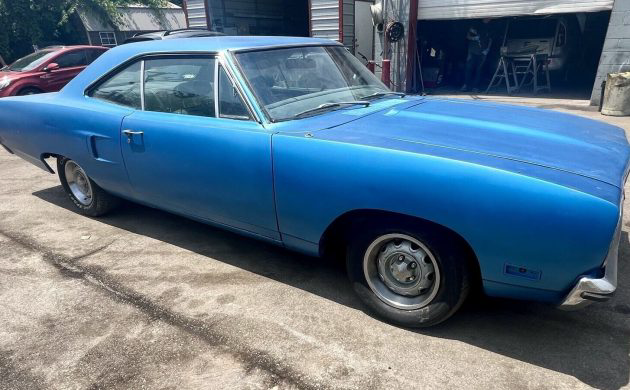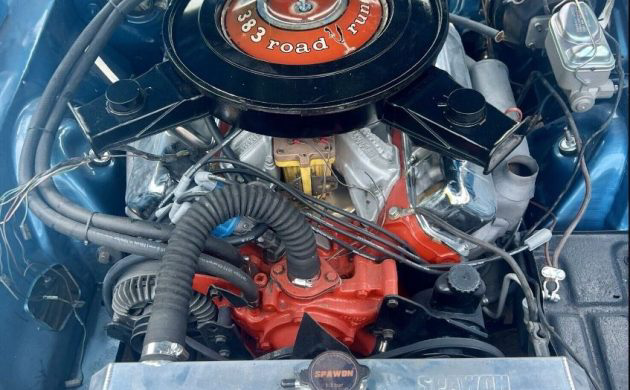It is fair to say that by 1970, America’s automotive landscape was changing dramatically. Manufacturers still produced muscle cars and high-performance models, but the specter of tightening emission and safety regulations saw large amounts of their development budgets funneled toward meeting those changes. Buyer demand had also cooled as insurance companies made the ownership experience more difficult and expensive. However, Detroit still rolled some great cars off the line, including this 1970 Plymouth Road Runner. It presents acceptably in its current form, but the fact that it is mechanically healthy and retains its numbers-matching drivetrain may motivate many to see it as an excellent restoration project. Why not take a close look to see if you agree?
The 1970 model year marked the end of the line for Plymouth’s First Generation Road Runner. Many enthusiasts hold these cars in high regard because they were the last to roll off the line before Chrysler began detuning its engine range. The first owner ordered this Plymouth in Cade B5 Blue Fire, which is confirmed via the Fender Tag and included original Broadcast Sheet. The paint shade might be original, but I believe this Road Runner may have received a repaint. It is presentable, although the lack of a decent shine will probably prompt the new owner to repeat the process. The panels are remarkably straight, with only a few minor bumps and bruises. The photos seem to confirm the seller’s claim that the floors are rock-solid, although they admit that a new trunk pan will find its way onto the shopping list. The prone lower extremities and the area surrounding the back window look sound, and the trim and glass are acceptable for a driver-grade restoration.
This Road Runner’s interior best demonstrates Plymouth’s approach to creating an affordable muscle car. The front seat is a vinyl-clad bench, while there are no creature comforts like power windows or a tilt wheel. However, the first owner selected desirable features like air conditioning and a Tick-Tock-Tach. The latter is intact, but the A/C components currently reside in the trunk. The entire interior looks rough and is begging for restoration. A car this desirable deserves a faithful approach, and kits to achieve a factory-fresh state are available. An interior retrim isn’t the cheapest part of any build, but using high-quality parts and taking the time to install everything properly will typically allow the finished product to present extremely well for decades.
Plymouth offered Road Runner buyers a decent selection of drivetrain combinations in 1970. This car features what many would consider the least potent, but that doesn’t mean it is a slug. The first owner selected the 383ci V8, a three-speed TorqueFlite transmission, and power-assisted steering and brakes. The 383 produced 335hp and 425 ft/lbs of torque when it rolled off the line, but the visible upgrades to the carburetor, intake, and ignition may have liberated a few more horses. The seller also replaced the fuel tank, radiator, front suspension, and a range of brake components. Purists might seek original items to return the engine bay to a more stock look, but that could happen as time and circumstances allow. The seller indicates that the drivetrain is numbers-matching and that the car runs and drives. They don’t mention if it is roadworthy. However, it appears that reaching that point if it isn’t won’t cost much time or money.
I am surprised that the auction action hasn’t been more spirited since the seller listed this 1970 Plymouth Road Runner here on eBay in Lexington, Kentucky. The listing opened at $13,500, and three bids pushed the price to $15,100 within the first ten hours, which is below the reserve. Things have gone quiet since then, with no bids submitted in the following three days. There is a BIN option of $26,000, which seems appropriate since Hagerty quotes a figure of $32,700 for a #4 example. The viewing history suggests a few people might be biding their time, striking in the auction’s final moments. Do you believe that is the case?







Great rendition of what was happening in the US auto scene, especially from someone not from here. Not sure his country was going through what we were. To add a bit, 1970 was the last gasp for the musclecar. While popularity dimmed some, they still sold over 41,000 Road Runners in 1970, not much more than the original. ’69 was the biggie with almost 84,000 sold. By 1970, it was clear to the insurance companies, in the wrong hands, and 90% were, these were death traps. Claims soared and something needed to be done. I don’t know all of it, feds got involved, and things like a tachometer, big motors or even a 4 speed, the premiums soared, so it wasn’t just gas prices. While the automatic wasn’t exactly rare, about half the 40,000 were autos, if you look at the option list a mile long, attention seemed to focus on luxury gee-gaws, and not neck snapping performance. It was the beginning of the end that many here witnessed. We had no idea what was to follow.
They sold so many because they were cheap junk!
Having owned an El Camino (SS454 4 spd flavor), I can attest to the performance of the Road Runner. Do I detect a bit of jealousy?
Actually, they sold so many because they were inexpensive. Their marketing was pure genius, because the demographic they were aiming for was more interested in performance than luxury. I’m not a Mopar guy, but the running gear offered in these cars was time tested, and very durable-and even the entry-level 383 delivered respectable performance.
The explanation that they sold well because they were “cheap junk” makes no sense.
Ripe for a Monaco tribute.
lol!
Something strange going on here. I don’t remember ever seeing any heat collectors on any 70 rr exhaust manifolds . No air grabber hood and a column auto. Thinking the location of the coil isn’t exactly the best place. On the other hand from the pictures there’s no rust around the rear window. Glwta! Peace!
Another sardine can emerges from the depth. Crackers anyone?
Wish the seller would have included a key to the trunk. We could have seen the extent of the NaCl worm living within the shadows.
They were cheap new and cheap used. I bought an FE5 70 RR hardtop in Nov. 1973 for $1,200 from the original owner. It had N96, black vinyl top, buckets, ps, pb, AM FM and optional wheels. It ran like stink, drove it every day. Only issue was it ate gas like a pig and that was the start of the Arab oil embargo. Gas shot up to 50 cents and I was a poor high school senior, who got laid off at the local gas station. They had great drivetrains, but it ended there. The interiors were junk and the front fenders started bubbling with rust even 51 years ago. So, when I see pristine, NO RUST Mopars from this era, well, I am suspicious.
Trunk and front face shots missing.
Larry,
Don’t wonder anymore. It’s because they are non-existent. Midwest “salt worm” consumed both ends of this “fine shiny one owner”.
Billy